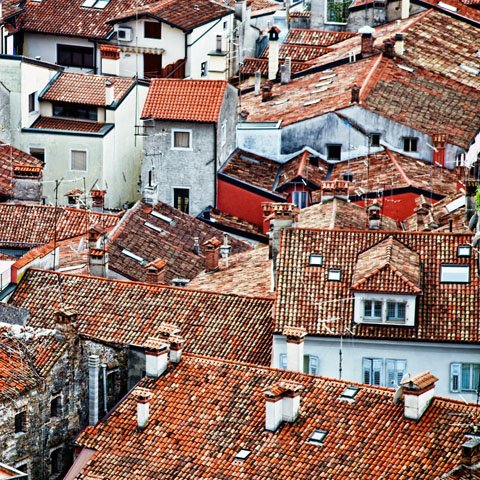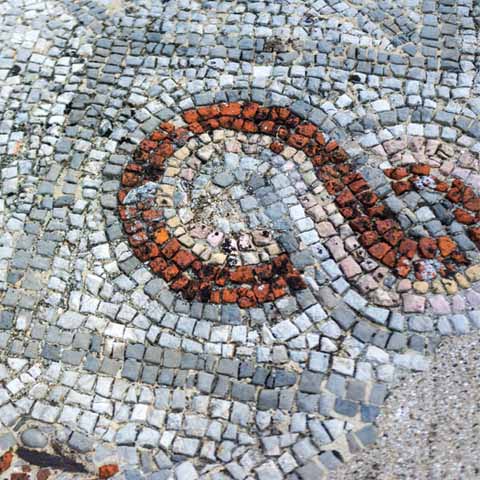Italy’s most northeastern border city of Gorizia is a unique melting pot of culture. This city has Austrian, Slovene, and Italian influences that have all come together to make the city a product of great diversity. Whether strolling around town through this garden city to examine the largely Austrian architecture or taking in some art at the Provincial Museum of History and Art, the city of Gorizia will both delight and entertain.
ARCHITECTURE
The Castello in Gorizia is a popular sightseeing stop. It sits atop a hill and can be reached by a steep road lined with bastions from the sixteenth century. Though the exterior of the castle is impressive on its own, inside the historic structure is the Museum of Medieval Gorizia. Here, travelers will find rooms furnished with centuries-old furniture in addition to medieval armor and other historic artifacts. The area surrounding the castle is home to a peaceful park area.
The Church of Santo Spirito is simply charming and sits below the Castello. The small and ancient church’s exterior is a mixture of dual colored stone patterns and features two arched windows, a rose window, a protruding door overhang, and church bells. Be sure to inquire about the church’s hours and touring options before visiting.
The Coronini Palace was built in the late sixteenth century and is located on the outskirts of Gorizia. The famous palace sustained damage during both World War I and World War II and became headquarters to a unit of the Italian Army. Eventually the building was returned to the Coronini family and Count Guglielmo Coronini and his sister began to make plans to transform the residence into a museum. Today, it is the site of a history and art museum.
The Church of St. Ignatius of Loyola in Gorizia is another must-see. The eighteenth-century church, which overlooks the Piazza della Vittoria, is stunning. The two-toned building boasts four stories with ornate detailing on the façade. Of particular note is the top of the exterior that features a simple cross in the middle which straddles a peculiar teardrop dome and cross on either side. The interior of the building is a continuation of exquisite attention to detail and ornate touches. The one-nave church has three chapels and almost more beauty than can be absorbed with one glance.
Perhaps the most important church in the city though is the Cathedral of Santi Ilario e Taziano Martiri. This grand church with Gothic and Baroque elements dates back to the thirteenth century but was not officially completed until the twentieth century. The church features a bell tower that was constructed in the sixteenth century. Inside, visitors can admire artwork by Giuseppe Tominz and fifteenth century reliquaries.
The Palazzo Lantieri in Gorizia’s historic city center is simply gorgeous. The historical dwelling features clean lines and impeccably kept grounds. The palace is quite large and features many arched entryways along the bottom floor of the building. The nearby park is home to a number of tall, winding trees and impressive displays of flowers. The palace is part of the Consortium for the Protection of the Historical Castles of Friuli Venezia Giulia.
ART
Gorizia is home to the Provincial Museum of History and Art, better known as Museo Provinciale di Storia e Arte to locals. Here visitors can find a rich collection of archeological items as well as examples of fine art including glass, ceramics, fabric, and various paintings.
Renowned Slovene painter, Franz Caucig is credited with being one of the best representatives of the Central European Neoclassicism style. Born in Gorizia, this eighteenth and nineteenth century painter’s works mainly depicted themes from Antiquity, the Bible, and the lives of Christian saints. He was known for drawings, altar paintings, and portraits. Perhaps his best-known painting is Judgement of Solomon.
Another famous artist of sorts was Nicolo Pacassi, an eighteenth-century Italian-Austrian architect. His family was from Gorizia and he was given much work for the Austrian Empire. In fact, in the mid-eighteenth century he was appointed court architect to the last ruler of the House of Habsburg, Maria Theresa of Austria.
The Sacrarium, which was completed in 1938, is a memorial dedicated to the fallen soldiers of World War I. The memorial takes the shape of a tower and fortress with a central crypt where the remains of 57,000 Italian soldiers and 539 Austro-Hungarian soldiers rest.
LITERATURE
Lorenzo Da Ponte was an eighteenth and nineteenth century Italian poet and writer of opera. Da Ponte wrote libretti for more than twenty-five operas, including some of Mozart’s. In the early nineteenth-century he left Europe amongst debt and bankruptcy to live in the United States, where he passed away in 1838 in New York.
Julius Kugy was a nineteenth and twentieth-century writer and mountaineer from Gorizia. Kugy is perhaps best known for his writings from traveling the Julian Alps that contemplate the relationship between man, nature, and culture. The mountaineer and his writings are so popular, a sculpture of him can be found in the Trenta Valley in the Julian Alps, where several mountain routes are also named after him. His works are still a treasure of Gorizia and Slovenia, prompting Slovenia to dedicate a postal stamp to Kugy in 2008.
Twentieth century Italian novelist Paolo Maurensig, was born in Gorizia. He pursued a number of different jobs including restoring antique musical instruments before settling on writing. Maurensig did not publish his first book, La variante di Lüneburg (The Lüneburg Variation), until after he turned fifty. His second work, Canone inverso, often heralded as his best, is the compelling story of a violin and its owners.
Located near Gorizia in the town of Sagrado, Ungaretti Park is dedicated to one of the most prominent Italian poets of the twentieth century, Giuseppe Ungaretti. During World War I, Ungaretti fought in the nearby area of San Martino del Carso, which was the scene of some of the worst battles of the war. Ungaretti’s experiences proved to be a source of inspiration for Il porto sepolto, his first poetry collection.
MUSIC
The art of music is still very much celebrated in the Gorizia area. In September, an international singing and violin competition is held. A few months later in November, opera season begins.
Musical great Rodolfo Lipizer is a product of the city. Born in Gorizia, this twentieth-century Italian musician was a violinist, orchestra conductor, and eventually a professor of music. His contributions to Gorizia music resulted in the International Violin Competition Rodolfo Lipizer Prize being named after him.
CINEMA
The FilmForum Festival is symbolic of Gorizia’s involvement with cinema. This international festival for contemporary visual arts and film culture recognizes cinematic greatness. The event typically offers participants meetings, conferences, workshops, and special film screenings.
While Gorizia does not make frequent appearances on the big screen, the city did serve as a setting for a few Italian films and Slovenian films, such as Eravamo quasi in cielo (2006) and History of Love (2018).
SCIENCE
Gorizia is the birthplace of Carlo Rubbia, an inventor and physicist. Rubbia won the 1984 Nobel Prize in Physics with Simon van der Meer thanks to their research in particle physics.
Plan your trip to Gorizia and feed the soul with the beauty of original architecture, music, and art that will forever capture your heart.
Don't just see Italy, live it.
Your dream trip to Italy has never been closer
No more endlessly scrolling travel sites. Our travel experts will craft the perfect, one-of-a-kind trip just for you.

300+
DESTINATIONS
We offer more Italian destinations than any travel site. Do and see more with Trips 2 Italy.
1 (of a kind)
ITINERARIES
Because your dream trip to Italy should be designed for you, not for the masses.
100%
PEACE OF MIND
From flights and accommodations, to food and activities - we take care of every detail.




